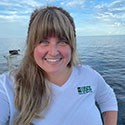Media Resources
This page provides members of the media with information, resources, and multimedia developed in association with the EXPRESS: West Coast Exploration series of expeditions.
Importance | Goals | Partners | Explorers | Videos & Images | Background Information | Contacts
From October 2022 through December 2023, NOAA Ocean Exploration and partners will conduct a series of telepresence-enabled ocean exploration expeditions on NOAA Ship Okeanos Explorer to improve knowledge about unexplored and poorly understood deepwater areas of the U.S. West Coast from Southern California to Washington.
The expeditions in 2023 will include mapping operations, remotely operated vehicle (ROV) dives, and autonomous underwater vehicle (AUV) operations, depending on the expedition:
- ROV and mapping: April 13 - 27
2023 Shakedown + EXPRESS West Coast Exploration (Portland, Oregon to Seattle, Washington) - AUV and mapping: October 21 - November 11
2023 EXPRESS: Exploration of Central California Coast (San Francisco, California to San Francisco, California) - AUV and mapping: November 30 - December 8
2023 EXPRESS: West Coast Exploration (San Francisco, California to San Francisco, California)
Importance of Operating Area
Along the Pacific Northwest coast, from northern California to southern British Columbia, lies a convergent tectonic boundary that stretches more than 1,000 kilometers (620 miles), providing a unique and fascinating setting for deep-ocean exploration. Geologically, the deep waters in the region feature submarine volcanism, large magnitude earthquakes, hydrothermal vents, and methane seeps with potential climate implications. Biologically, these waters contain a variety of marine life supported by an abundance of hard surfaces available on seamounts and canyons as well as along hydrothermal vents. In addition, these waters provide a known migration corridor for species such as tuna, sharks, and whales.
Because of its active geological features, rich biodiversity, and proximity to the coastline, scientists have been studying these deep waters for decades. Nevertheless, there is still much to be learned about the deep-ocean environment in this region and its geological and biological systems and how they influence each other.
During the second 2023 EXPRESS expedition, NOAA Ocean Exploration will lead an expedition on Okeanos Explorer off central California in and around the proposed Chumash Heritage National Marine Sanctuary. The area is recognized as a biological hotspot for birds, marine mammals, sea turtles, fish, other marine organisms, and algae, like kelp. The area includes thriving ecological habitats such as kelp forests, rocky reefs, and sandy beaches, as well as unique and important offshore geological features, all home to unique and rare deep-sea corals and sponges. Importantly, the proposed sanctuary sits between existing marine protected areas, enhancing opportunities for ecological connectivity and protected corridors for fish and wildlife.
Designation of the sanctuary would advance President Biden's America the Beautiful Initiative, which is supporting locally led conservation efforts across the country with a goal to conserve and restore 30 percent of U.S. lands and waters by 2030.
Four Key Things to Know About the Expeditions
- We will map, survey, and sample geologic features in order to better understand the geologic context and potential geohazards along the U.S. West Coast and Cascadia Subduction Zone convergent plate boundary. The margin along this tectonic boundary has been the site of “megathrust” earthquakes in the region, the extent and occurrence of which is poorly understood, limiting our ability to assess earthquake and tsunami hazards and adequately prepare for future events. This margin is also the site of thousands of recently discovered methane seeps that provide important habitat for marine life and could play an important role in ocean warming. Geological data collected during the EXPRESS: West Coast Exploration expeditions will increase our understanding of the region’s geological history, enhance our ability to predict potential future geohazards, and provide insights into methane inputs into the ocean, which in turn has implications for climate change.
- These West Coast expeditions will yield data to help scientists and policymakers understand the diversity and extent of coral and sponge communities in the region. Coral and sponge communities represent some of the most valuable marine ecosystems on the planet, creating structures that provide shelter, food, and nursery habitat to invertebrates and fish. As corals and sponges are fixed in place and generally long-lived and slow-growing, they are particularly vulnerable to human activities such as bottom contact fishing gear, seabed mining, and associated environmental change. Recent research has significantly contributed to our understanding and appreciation of corals and sponges, but there is still a great deal to learn about their distribution, diversity, reproduction, and resilience, particularly in the unexplored and poorly understood deepwater areas where we will be exploring.
- We will explore deep-sea canyons and seamounts, to better understand the biology and geology of these prominent and important features along the West Coast. These habitats are generally regarded as hotspots of biodiversity, as they harbor a great abundance and diversity of marine organisms, including commercially, recreationally, and ecologically important species. Exploration of these submarine canyons and seamounts may also offer insights into the geologic history of the region and help us better assess the potential for natural hazard events such as submarine landslides.
- This West Coast series of expeditions will contribute to EXpanding Pacific Research and Exploration of Submerged Systems (EXPRESS), a multiyear, multipartner cooperative research campaign in deepwater areas of California, Oregon, and Washington, including the continental shelf and slope. Data and information collected during the EXPRESS campaign are intended to guide wise use of living marine resources and habitats, inform ocean energy and mineral resource decisions, and improve offshore hazard assessments. Co-led by NOAA, the U.S. Geological Survey, and the Bureau of Ocean Energy Management, EXPRESS builds on the momentum of past U.S. campaigns and international initiatives to support ecosystem-based management of marine resources and technologies. The partnership component of EXPRESS allows federal and non-federal entities to collaborate in identified priority areas that directly support the National Strategy for Ocean Mapping, Exploration, and Characterization and provides an opportunity to highlight the uniqueness and importance of deepwater environments.
Goals of the Expeditions
The EXPRESS: West Coast Exploration series of expeditions will address science themes and priority areas put forward by scientists and managers from NOAA, management agencies in the region, and the ocean science community. NOAA priorities for each expedition include a combination of science, education, outreach, and open data objectives that will support management decisions at multiple levels. Specific goals include:
- Improving knowledge of unexplored deepwater areas along the U.S. West Coast to inform management needs for sensitive habitats, geological features, and potential resources.
- Locating and characterizing deep-sea coral, sponge, and hydrothermal communities.
- Collecting high-resolution bathymetry in areas with no or low-quality sonar data to extend bathymetric mapping coverage in support of the National Strategy for Mapping, Exploring, and Characterizing the United States Exclusive Economic Zone and Seabed 2030.
- Ground truthing existing bathymetric data, habitat suitability models, seafloor composition models, and inferred vent sites.
- Characterizing water column habitats using acoustics, visual observations, and emerging technologies.
- Collecting data to enhance predictive capabilities for vulnerable marine habitats, seafloor composition, seamount formation, plate tectonics, hydrothermal vents, critical minerals, and submarine geohazards.
- Investigating biogeographic patterns of deep-sea ecosystems and connectivity for use in broader comparisons of deepwater habitats throughout the Pacific basin.
- Mapping, surveying, and sampling geological features, including convergent plate boundaries, hydrothermal vents, extinct polymetallic sulfide systems, and fracture and fault zones to better understand the geological context of the region and improve knowledge of past and potential future geohazards.
- Engaging a broad spectrum of the scientific community and public in telepresence-based exploration and providing publicly accessible data and information products to spur further exploration, research, and management activities.
EXPRESS Partners
Led by NOAA Research's NOAA Ocean Exploration, the EXPRESS: West Coast Exploration expeditions on Okeanos Explorer involve a number of partners including the Office of Marine and Aviation Operations, NOAA Satellite’s National Centers for Environmental Information, NOAA’s National Ocean Service, NOAA Fisheries, and the Global Foundation for Ocean Exploration. Primary partners for the EXPRESS campaign include the U.S. Geological Survey, the Bureau for Ocean Energy Management, and MBARI (the Monterey Bay Aquarium Research Institute).
Explorers
The individuals listed below were the primary leads for the first EXPRESS expedition. They coordinated input from multiple scientists and managers participating from shore to plan dives, were several of the voices you heard on the live video feeds, and were the primary participants in outreach events that took place during the expedition. Information about the leads for the other EXPRESS: West Coast Exploration expeditions can be found on respective expedition web pages .

Paige Koenig
Science Co-Lead (Geology), Western Washington University
Paige Koenig is a second-year master’s student in the Geology Department at Western Washington University. She grew up in Denver, Colorado, and received her B.Sc. in environmental science from the University of Redlands. She currently works as a graduate research assistant in the marine geophysics lab studying how small-scale seafloor structures influence natural hazards. Her master’s thesis uses one-meter resolution multibeam acquired from autonomous underwater vehicle Sentry to investigate how the tectonic geomorphology of the Gofar oceanic transform fault influences the seismicity observed there. She currently lives in Bellingham, Washington, and enjoys sea-going activities such as kayaking and polar plunging.

Alexis Weinnig
Science Co-Lead (Biology), U.S. Geological Survey
Alexis Weinnig is a postdoctoral researcher with the U.S. Geological Survey at the Easter Ecological Science Center in Kearneysville, West Virginia. She holds a B.S. in oceanography from Florida Institute of Technology, an M.S. in ecology, evolution, and conservation biology from San Francisco State University, and a Ph.D. in biology from Temple University. This will be Alexis’ second time acting as a Science Lead aboard NOAA Ship Okeanos Explorer, and she has over eight years of experience in deep-sea ecology, with an emphasis in deep-sea coral habitats, population connectivity, and eDNA. Alexis has participated in 14 research expeditions using submersibles, amounting to over 270 days at sea, in the Atlantic, Gulf of Mexico, and Pacific focused on seamount, cold-seep, canyon, and deep-sea coral habitats.

Thomas Morrow
Expedition Coordinator, NOAA Ocean Exploration
Thomas Morrow is a physical scientist with NOAA Ocean Exploration. He spends his time working as an expedition coordinator on NOAA Ship Okeanos Explorer and supporting NOAA’s ocean exploration mission. Thomas is a marine geologist and geophysicist who started his ocean exploration career while earning his bachelor’s degree in geology at the University of Florida. He then moved to the University of Idaho for master’s and doctorate degrees in geological sciences, studying mid-ocean ridges, fracture zones, and hotspot seamounts. Prior to joining NOAA Ocean Exploration, Thomas spent several years as a postdoctoral research fellow at Boston College, coordinating missions to explore the Gofar transform fault on Research Vessel Atlantis and Research Vessel Thomas G. Thompson.
Videos and Images
Dive highlight videos, short video clips, and photos will be posted online in the expedition gallery as they become available.
Images and video collected during EXPRESS: West Coast Exploration expeditions on Okeanos Explorer are in the public domain, meaning they are free to use without restrictions or additional permissions, provided that the credit information listed in the caption associated with each image or video is included. If space is limited, please credit NOAA Ocean Exploration (preferred) or NOAA.
Please contact Emily Crum for high-resolution footage, b-roll, and other materials posted on the NOAA Ocean Exploration website.
For additional information, please view our online media kit.
NOAA Ocean Exploration Background Information
- NOAA Ocean Exploration is dedicated to exploring the unknown ocean, unlocking its potential through scientific discovery, technological advancements, and data delivery. We are leading national efforts to fill gaps in our basic understanding of the marine environment, providing critical ocean data, information, and awareness needed to strengthen the economy, health, and security of the United States and the world. In 2021, we celebrated our 20th anniversary of deep-ocean exploration.
- NOAA Ocean Exploration’s work supports the National Strategy for Mapping, Exploring, and Characterizing the United States Exclusive Economic Zone, which calls for coordinating interagency mapping and exploration activities for the U.S. Exclusive Economic Zone (EEZ), developing new and emerging science and mapping technologies, building public and private partnerships, and completing mapping of the deep water of the U.S. EEZ by 2030 and the near shore by 2040.
- NOAA Ocean Exploration owns the mission equipment being used during the expedition and is coordinating the mission on NOAA Ship Okeanos Explorer. The ship is operated by the NOAA Commissioned Officer Corps and civilians as part of NOAA's fleet managed by the NOAA Office of Marine and Aviation Operations and the remotely operated vehicles are operated in partnership with the Global Foundation for Ocean Exploration.
- Unlike many other ocean expeditions supported by NOAA, most of the scientists participating in expeditions on Okeanos Explorer remain on shore, thanks to telepresence technology. This technology includes a high-bandwidth satellite connection that enables the transmission of data and video to shore in real time, allowing scientists to participate in the expedition from anywhere in the world.
- Anyone with an internet connection can follow the expedition — LIVE. The same technology that allows scientists around the world to participate in the expedition from shore also enables interested members of the public to experience deep-sea exploration, the wonder of discovery, and the fascination of science in real time through the internet.
- Data collected during expeditions on Okeanos Explorer are quality assured and then made quickly available to scientists and the public. This data collection serves as a unique and centralized national resource of critical ocean information for scientists and resource managers to plan future research, make management decisions, detect natural hazards, improve nautical charts, and more.
Media Contact Information
Emily Crum
Communications Specialist
Email Address: ocean-explore-comms@noaa.gov
Keeley Belva
Public Affairs Officer
Email Address: keeley.belva@noaa.gov
Additional contacts for 2023 EXPRESS: Exploration of Central California Coast
Sarah Marquis
West Coast/Pacific Media Coordinator
Email Address: sarah.marquis@noaa.gov
Shauna Fry
Outreach Coordinator
Email Address: shauna.fry@noaa.gov